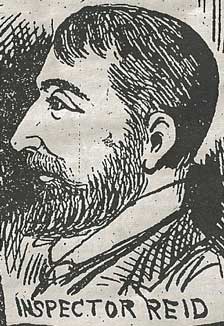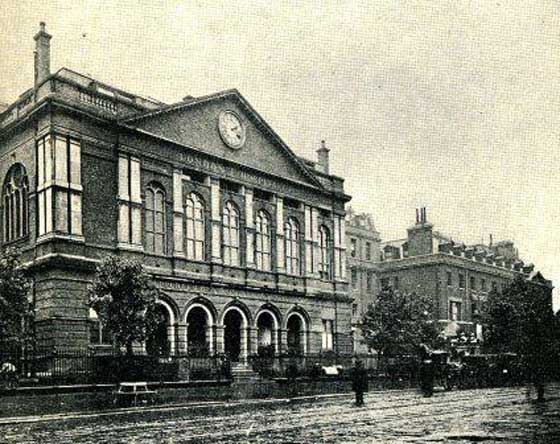Although 1888 is, nowadays, chiefly remembered as the year of the Jack the Ripper murders, there were other violent crimes that took place in that year, a large percentage of them occurring in Whitechapel.
Wherever possible, it is quite intriguing to trace the progress of the investigation into a particular crime from when it was committed through to the outcome of the case, when the perpetrator was brought to justice and appeared in court.
If nothing else, these “complete” cases illustrate the twists and turns of a police investigation, together with some of the misinformation that appeared in the newspapers in relation to the crimes.
One such case occurred in Whitechapel on Tuesday, 26th June 1888.
ALLEGED ATTEMPTED MURDER IN WHITECHAPEL
The Globe, broke the story on Thursday, 28th June, 1888:-
“About eight o’clock on Tuesday night, when the thunderstorm was at its height, loud screams were heard coming from the front top room of No. 18, Grove-street, Commercial-road, Whitechapel, which is in the occupation Richard Patterson, dock labourer.
Mrs. Patterson was then seen to emerge from the front door, bleeding from several wounds, and holding a handkerchief to her neck. The woman ran to the top of the street, and then she fell to the ground in an exhausted condition.
TAKEN TO THE LONDON HOSPITAL
A barrow was procured, and Mrs. Patterson was placed in it and was conveyed to the London Hospital, where it was found that she was suffering from four wounds. These were dressed by Dr. Giddings, the house surgeon.
HER BROTHER EMERGED BLEEDING
Directly after the woman had been taken to the hospital, the neighbours said her brother ran out of the house, and he was bleeding from no fewer than eight wounds, which he said had been inflicted by Richard Patterson with a carving knife.
The injured man was taken to the hospital and his wounds were dressed.
THE POLICE ON THE SCENE
Within a few minutes of the occurrence, Detective-Inspector Reid, with Detective-Sergeants White, New, and other officers, appeared on the scene, and it was then found that Patterson had made his escape by scaling the wall at the back of the house.

A SHOCKING SCENE
The room presented a shocking appearance, being covered with blood, and looking, so the officers said, “just like a slaughterhouse.”
Both the injured persons are doing as well as can be expected.
THE WANTED MAN
The description of Richard Patterson is as follows:- Age, about 28, small, fair moustache, and fair complexion; scar on forehead; “A. B.” tattooed on the arm; irregular top front teeth, and 5ft. 7in. in height. He was wearing a bottle-green coat and vest, felt hat, and dark trousers.
It is supposed the brother intervened to protect his sister, when Patterson attacked him.
Patterson is well known in the neighbourhood of the docks.”
MURDER OF A YOUNG WIFE
The Croydon Chronicle and East Surrey Advertiser on Saturday, 30th June, 1888, reported, wrongly as it happened, that a murder had, in fact, taken place:-
“The attention of the inhabitants of a street in Whitechapel was drawn the other evening by a series of shrieks, to a house inhabited by a labouring man named Richard Paterson.
A lodger in the house was seen standing at the door and proclaiming the fact that Paterson had cut his wife’s throat and severely gashed the face of her brother.
The police were called and the woman was conveyed to the London Hospital, where she expired.
The brother was taken to the same institution later on, and it is hoped he may recover.
Paterson, who immediately made his escape, is 26 years of age, of medium height, and complexion.

A VERY BAD CHARACTER
He bears a very bad character, and before he was married, in the course of a quarrel with his victim, he stabbed her, marrying her only to avoid the prosecution with which he was threatened.
A few months ago, he lost a child by her accidental drowning in a washing tub, and to assist him in defraying the expenses consequent on the funeral a “friendly lead” was got up for him. This placed him in possession of funds. Since then he has been more or less dissipated in his habits.
The only motive assigned for his act is jealousy; but the neighbours give the murdered woman a very good character.”
THE ATTEMPTED MURDER AT POPLAR.
As it happened, the report that Mrs. Patterson had died was wrong, as evidenced by the following update, which appeared in Lloyd’s Weekly Newspaper, on Sunday, 1st July, 1888:-
“Mrs. Agnes Paterson and John Barry, who were murderously assaulted by Richard Paterson, the former’s husband, at 18, Grove-street, Commercial-road, on Tuesday night last, were yesterday reported to be much better.
The former will be able to leave the London hospital in a few days, and Barry in probably a fortnight.
NO SIGN OF PATERSON
Detective-inspector Reid informed the reporter that the whereabouts of Paterson had not yet been ascertained.
He has not been to work since the assault.
A DRUNKEN ARGUMENT
It is again stated that the woman was drunk on the night it occurred, that she greatly annoyed Paterson by brawling and singing, and when spoken to she took up a paraffin lamp and threw it at him, striking his forehead with considerable violence.
It was then that the man stabbed her, the knife passing through her chin, and coming out in the neck, and on the brother interfering, he also was stabbed.
Paterson bears a good character at the East Quay, London docks, where he has been employed for the past nine years.”
ATTEMPTED DOUBLE MURDER
The Scotsman, on Thursday 16th August, 1888. contained the following update on the case:-
“Richard Patterson (28), labourer, gave himself up to the Metropolitan police yesterday and was charged at the Thames Police Court in the afternoon with attempting to murder his wife and her brother, on the 26th June, at Whitechapel, with a carving knife. He was remanded.”
RICHARD PATTERSON IN COURT
Patterson next appeared in court on Wednesday, 23rd August, 1888, and The East London Observer published a report on the proceedings in its edition of Saturday, 25th August, 1888:-
“Today, before Mr. Lushington, at the Thames Police-court, Richard Patterson, [28], described as a dock labourer, no home, was brought up on remand, charged with attempting to murder his wife, Annie Patterson, by stabbing her with a carving knife, on June 26, at 18, Grove-street, Whitechapel.
He was further charged with attempting to kill and slay John Barry by stabbing him with the same knife at the same time and place.
Detective-inspector E. Reid, H division, watched the case for the Criminal Investigation Department, and Mr. B. Taylor, barrister, defended.
THE WIFE’S TESTIMONY
Mrs. Patterson, recalled, deposed on the day in question she came home very drunk, picked up a plate and flung it at her husband. He picked up a lamp and threw it at her. Witness went out the first thing next morning and did not return until the evening. She then found the door shut, whereupon she burst it open.
The accused and his little boy, Richard, came up the stairs, and witness spat in her husband’s face several times. He then hit her with his hands, and she threw several cups at him.
Prisoner then went downstairs and, shortly afterwards, returned with witness’s brother, John Barry.
The accused then went to a cupboard and took out a carving knife. She did not see any more or feel anything. She was cut four times-once on the finger, twice on the face, and also once on the arm, but she expected she got that when she tried to protect herself. Her husband inflicted the wounds.
The police came and took her to the London Hospital.
Witness did not know what became of her husband. She was in the hospital a fortnight in consequence of the injuries she received. The accused was very drunk, and the witness was as bad.
JOHN BARRY’S EVIDENCE
John Barry also deposed that the prisoner’s wife complained to him of her husband’s ill-usage, and witness said if he wanted to hit her he might use his hands. Prisoner then got a carving knife, and witness said, “What have you got that for, Dick?”
The accused then stabbed him in the jaw with it.
His sister screamed, and then the prisoner struck her with the knife. Witness received eight wounds.
Prisoner kept on stabbing him and his sister, and they were afterwards taken to the London Hospital. Witness was there for four weeks.
The accused said nothing when he attacked them.
THE INJURIES THEY SUFFERED
Dr. T. G Giddings, house-surgeon at the London Hospital, stated the prosecutrix was brought in the hospital about a quarter-past eight on the night of June 26.
He found over the lower part of the left side of the face a clean-cut wound 2in. in length and half an inch in depth, which bled profusely. Over the chin on the left side was a punctured wound 1 and a half inches in length extending down to the jaw, baring and splintering the bone. On the outer side of the left forearm, just below the elbow, there was a punctured wound, 1in. in length. On the middle finger of the left hand was a transverse wound in the fold of the last joint, half an inch in length.
On Barry he found a wound on the left shoulder, going under the skin for 3in. and appearing through the skin at the back. In front of the left ear was a wound 1in. in length, extending downwards 2½in. There was a lacerated wound on the left cheek, extending down to another wound which was on the left side of the lower lip. On the centre of the forehead was an incised wound, two inches long, and a quarter of an inch in depth. Between the thumb and forefinger of the left hand was an incised wound with a scratch extending over the back of the hand. On the inner side of the right hand was a punctured wound.
PATTERSON’S SURRENDER
Constable 39 H said on the 15th inst, the accused came to the Arbour-square Police-station and said “I am the man you are looking for. I am Richard Patterson. I give myself up. I am tired of walking about.”
INSPECTOR REID DESCRIBES THE SCENE
Inspector E. Reid said he received information of the stabbing shortly after the occurrence. He made a search for the knife, but could not find it. There was a pool of blood in the room and on the stairs, and spots of blood on the walls.
The room was in a filthy condition, and in it he found a broken paraffin lamp.
On the 15th inst. he told the prisoner the charge, and in reply, he said. “I threw the knife on the floor.”
COMMITTED FOR TRAIL
Mr. Lushington committed the prisoner for trial for wounding his wife with intent to disfigure her, and with intent to do his brother-in-law grievous bodily harm.
Inspector Reid mentioned that some time since the prisoner had shot at his wife.”
HE APPEARS AT THE OLD BAILEY
On the 17th September, 1888, Richard Patterson appeared at the Central Criminal Court (The Old Bailey) charged with feloniously wounding John Barry, with intent to murder. He was also charged on a Second Count, to do grievous bodily harm.
He was found guilty on both counts, and he then pleaded guilty to wounding Ann Patterson with intent to do her grievous bodily harm.
The judge sentenced him to five years penal servitude.
FURTHER INFORMATION
You can read the full transcript of his Old Bailey Trail here.
